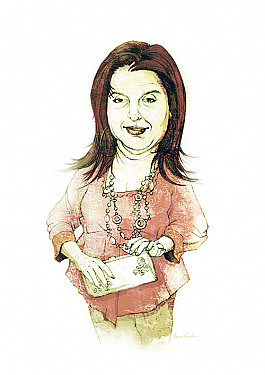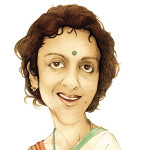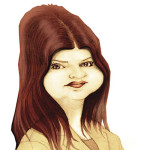The New Heroine
The popular perception of women in the film industry used to be that they were victims in some way. Today, women actors are definitely not victims. If they are here, it is because they want to be! The women I work with are sharp, shrewd and know exactly what they are doing and where they are heading.
Many things have changed for women in the film industry… and it is a change for the better. The heroines are all independent girls – they have a mind of their own, they do their own thing; they travel across the world on their own and, most importantly, they are confident of making their own business decisions. Unlike in the past, today hardly any actress comes with her mother in tow. It is no longer ‘Ask Mummy’. In fact, Mummy has to ask her confident daughter what to do.
The scenario will change further, but if we are to indulge in future speak, I cannot say how radically it will change.
Let me emphasise here that when we talk about women in cinema, a distinction has to be made. I don’t think technicians and actresses should be put in the same slot for a variety of reasons. I am going to be 46 and I feel my career is still in the making. For an actress, being 46 means that you are already 200 years old. That has not changed over the years and is unlikely to change in the future.
I was a choreographer first, I then turned director and I am now going to act in a film! But for a heroine, her screen time lasts for about 10 to 12 years. Perhaps one or two heroines may escape this fate. Kajol, for instance, who even after getting married and having two kids, can find takers if she wants to come back. But that is because she never over-exposed herself earlier.
The fact remains that women age faster on screen. Men may grow older in real life, but in reel life they still romance much younger women. In fact, in Om Shanti Om Deepika Padukone kind of spoilt the first romantic scene with Shah Rukh Khan by telling him that she had loved seeing Kuch Kuch Hota Hai when she was seven or eight years old! Her remark sent him into a state of shock. Other than that, opportunities for women in the industry have expanded hugely. I was the first girl assistant director in Jo Jeeta Wohi Sikander but by the time I did Om Shanti Om, Main Hoon Na and Tees Maar Khan, 90 per cent of my team was made up of girls, and they were perhaps more efficient than the boys. Having said that let me point out that it took a lot to break the glass barrier and to make successful commercial movies.
Today, people are far more accepting of women. I got married at 39, my husband is eight years younger than I am and he is happy with that. The role of women is changing off-screen and on, and that has a lot to do with the changing mental psyche of men. I saw Tanu Weds Manu recently. Ten years ago, the girl would have been considered a tart. But the film did well. She was a free-spirited girl who wanted to go with every guy she saw. The pativrata woman who takes dust from her husband’s feet and puts it in her maang will mostly get booed and heckled.
Of course, you can argue that heroines are still here largely for the glamour quotient. My argument is that they want to be the glamour quotient. They know that their one item song is going to make them crores of rupees. They know that they cannot dance to their dialogues at award ceremonies and shows.
And, importantly, they are comfortable doing whatever they are doing. There are times when I hesitate to ask an actress to wear something but she will turn around and ask me why she is given such fuddy-duddy outfits. The women on screen today are very fit. They have great bodies and want to flaunt them. They are comfortable doing kissing scenes, wearing bikinis. In fact, Katrina Kaif was so comfortable in Sheila ki Jawaani that she would walk out in her costume – with no towel or gown covering her – and sit on the sets right through the shoot.
Film roles are changing too and actresses are today getting their due. Priyanka Chopra gets to do a 7 Khoon Maaf and even a What’s Your Rashee. Vidya Balan does Ishqiya or Dirty Picture. It is true that no one is going to make a 50 or 60-crore movie revolving around a woman without a big hero behind her. But that happens in Hollywood too.
It’s unfortunate that in India no fun movies are being made with the girls like, say, Charlie’s Angels. There are good roles for women in issue-based films – serious, thought-provoking, perhaps a bit boring, roles. It’s still a no-no for a movie to have a woman at its centre. I had to break through that when I began making movies. If I can change the dimensions, then so can other women. So that is something that can and should change in the coming years.
Changes on screen are dictated largely by the most important off-screen element – the audience. A large part of the audience’s reaction to a movie is based on its reaction to the heroine. It is perhaps the element that attracts me to her when I go to watch a movie. She may not be the most beautiful woman on screen but she has to still look pretty. In India we don’t want to see ugly faces on screen; we want our girls to be pretty. In Hollywood you find some strange looking actresses doing main roles, and doing them well. But here, by and large, everyone is nice looking if not beautiful.
To succeed the heroine must also connect with the audience. There is a willingness on the part of actresses to go the extra mile and the audience senses that. The girls never look disinterested in what they are doing. No wonder then that the tables have turned, and so well, for a Priyanka or a Katrina.
An interesting development is that there are no vamps on the screen any more – no Helen or Bindu. Those roles are absolutely obsolete. There are grey or negative characters in a script and the heroines will play those roles. The ‘good’ heroine was never allowed to wear revealing clothes but today that concept has been thrown into the kachre ka dabba.
Double standards are slowly vanishing from the movies. The belief that women are vestal virgins who have never been touched even at the age of 35, is no longer valid. Audiences accept that the man is not her first love; he may be her second, third or fourth lover. That is a healthy trend. In OSO the one doubt that was raised was, will the audience accept that Deepika, who is in love with a producer who is actually having an affair on the side, is not a virgin? Tried and tested people in the industry told me that this may matter to the audience. But ultimately, they felt sorry for her and the fact that she was being cheated upon.
In the case of multiplex audiences tastes have changed a lot. In a movie like No One Killed Jessica I was amazed at Rani Mukherji’s attitude. She was sleeping around, used abusive language, and yet came across as a woman of conviction. No one had moral objections to her character. All this means that cinema is in touch with reality and does not perpetuate a myth. In my next movie my heroine is a bar dancer, no holds barred. That is her job and what she does.
Yet, I do not know if the heroines will ever replace the guys, not even 10 years down the line. Even abroad, the biggest movies are still being made with Tom Cruise and Tom Hanks or whoever.
In my own movies it is true that all my heroines are mostly glamorous. But whichever girl I am working with, I like to break the mould she was in earlier. If it is a Katrina, I will make her look sexy and make her dance well. Or I will dress Sushmita Sen, who was seen earlier in leather pants and corsets, in something softer. Unfortunately, however big an actress you are, however talented you are, you still tend to judge your self-worth by who your hero is. Am I doing a movie with Shah Rukh, Salman or Aamir Khan?
We still have to make a big commercial action movie with a woman at the centre. Movies like the Lara Croft series. If you announce a movie with a big heroine at the centre, it is assumed that you are doing so because you cannot get a big hero. But if we are able to pull it off and do something like Anjolie Jolie’s Salt that rides purely on her own name, we will break the ceiling. We might be able to pull it off in the next few years.
I like it that actresses are more open about their personal lives. Earlier, they would hide their affairs, their boyfriends. Now, if you want to become a bigger star, you talk about all that otherwise you will be called boring.
Ten years down the line, things willbe bigger, better…and more beautiful for women.
Related posts from Verve:
Verve Trending
Sorry. No data so far.
us on Facebook to stay updated with the latest trends






